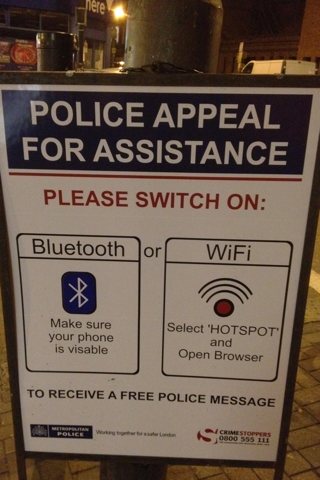 This sign, one of many that have appeared around Clapham Junction after the recent murder there, caught my attention. It struck me as a surprisingly innovative approach to witness appeals, especially as the police (with good reason) place a lot of faith in traditional, tried and tested, approaches.
This sign, one of many that have appeared around Clapham Junction after the recent murder there, caught my attention. It struck me as a surprisingly innovative approach to witness appeals, especially as the police (with good reason) place a lot of faith in traditional, tried and tested, approaches.
A few thoughts, positive and negative, occurred to me.
- Positive. As this is generic, it can be used almost immediately. I often thought that the old yellow boards probably didn’t help that much: they took time to make and place and the human memory is unreliable, meaning they perhaps didn’t gather much information while also serving to increase the fear of crime.
- Positive. Because it’s different, it attracts attention. People go numb to familiar items, and even though the yellow information boards may crop up in new places, I wonder how many are largely ignored.
- Negative. How many people are missed, either because they don’t have a smart phone, or more likely, aren’t familiar with functions that they don’t use that often? And even though I am familiar with my phone, it took a few minutes to connect (and the Bluetooth option didn’t produce any message at all).
- Negative. For years community safety messaging has discouraged people from getting their phones out as soon as they leave the station because it merely helps advertise high value goods in crowded places (in much the same way as ‘pick-pockets operate here’ signs aren’t that great, because most people instinctively feel their pockets to check wallets and purses, helping the pick-pocket find a target).
- Negative. Given the rise in identity theft and the increasing amount of personal information we use online and through mobile internet, isn’t it a little dangerous to encourage people to connect to horribly generic hotspots?
Is it a use of technology for the sake of it? I don’t know, but I’d be fascinated to see any long-term study of the results of different methods of witness appeal. And of course, the value of evidence may well outweigh the disadvantages of any particular method and that’s a judgement call the police have to make.
This particular appeal relates to the murder of Richard Ward, for which two arrests have been made, but if you have any information you can call the incident room on 020 8721 4961 or Crimestoppers anonymously on 0800 555 111.

 Neighbourhood policing
Neighbourhood policing